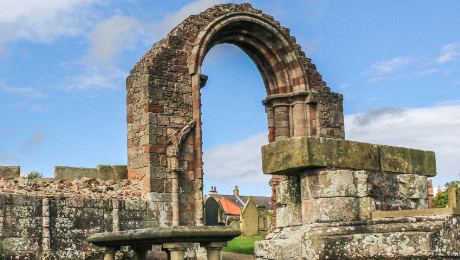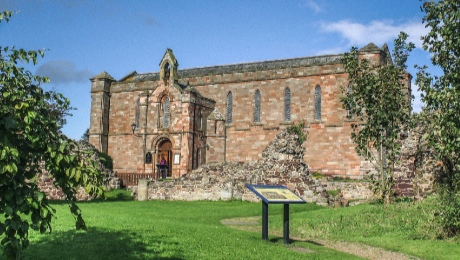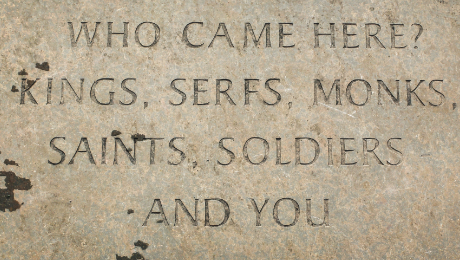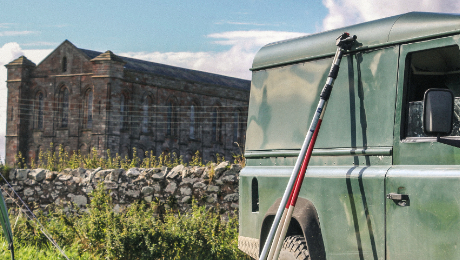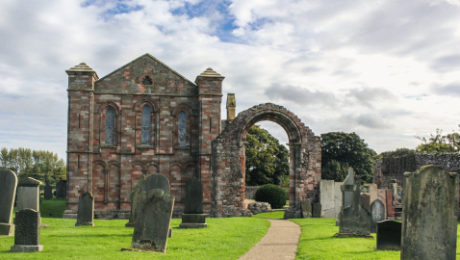Today, Coldingham is a village in the Scottish Borders with a gorgeous medieval priory at its heart. But there’s something much, much older there too… an early Christian monastery founded by Saint Æbba around 640 AD.
Æbbe was born 615 AD into a noble family; she was a princess, the daughter of the first king of Northumbria. When he was killed, her mother Acha rounded up her children and fled to the Kingdom of Dál Riata.
The story begins
Dál Riata was a kingdom that incorporated much of modern day western Scotland and north-eastern Ireland. It was a hub of early Christianity, with many religious centres springing up, the most famous of which is probably Saint Columba’s monastery at Iona.
Being under the protection of the kings of Dál Riata, Æbbe and her family (including her brother Oswald) soon converted to Christianity.
Around 635 AD, Æbbe’s brother, King Oswald, regained control of Northumbria and introduced monks who followed the teachings of Saint Columba to the island of Lindisfarne. He did this in order to Christianise his people, who were still largely a pagan population.
With Northumbria recaptured, and with her brother on the throne, Æbbe was able to follow him home, and support his mission to spread Christianity along the north east coast. And with Prince Aidan attempting to gain her hand in marriage – a man she clearly undesirable found detestable – she decided to reject his advances in the one way noble women of the time were able to: by founding a monastery and becoming a nun.
Starting with a monastery at Ebchester, Æbbe soon started a second – this time just 25 miles up the coast from her brother’s monastery at Lindisfarne.
Unlike Lindisfarne, Æbbe’s monastery was home to both monks and nuns, and was recorded by the name of ‘Urbs Coludi’ by the medieval historian, Bede.
It later became known as Colodaesburg in Anglo-Saxon, and then Coldingham. We don’t know the full extent of the power Coldingham had in the surrounding area, but with a royal founder and close ties to Lindisfarne, it’s likely that Coldingham was rather more influential than Bede let on in his writings.
Æbbe the abbess
What Bede does bring to our attention is that Æbbe had a difficult time enforcing discipline at Coldingham. Early Christian monasteries were often founded and frequented by noble families, and therefore they were associated with eating, drinking and entertainment, not the strict pious places we might think of today. It wasn’t long before the monks and nuns at Coldingham became worldly and unruly.
In fact, Coldingham became so rowdy that Saint Cuthbert eventually visited to instruct the community and enforce some control. It was said that every evening he would walk out into the sea until he was neck deep to bathe, staying in the water until dawn to avoid succumbing to temptations of the flesh.
A curious monk decided to follow him one evening, and spied on Cuthbert to find out what he was doing every night when he left the monastery. The monk watched as Cuthbert sang psalms from the sea until dawn. When Cuthbert finally came back to shore he was followed by two otters; they warmed his ice cold feet and dried him with their fur.
Æbbe’s legacy
Sadly, Æbbe’s legacy was not to last. The fall of the Æbbe’s monastery was prophesised during a visit from Adamnan, the abbot of Iona. It burned down in AD 683, shortly after her death.
The tragedy was blamed on the disorderly behaviour of the monks and nuns who resided there. The monastery was rebuilt, but this time it was only home to a small community of nuns. Viking raiders destroyed the second monastery less than 200 years later, in 870AD.
Since then, Coldingham has been rebuilt and destroyed again and again. It was even burned down at one stage by its own prior, William Drax, in his attempt to cover the fact he’d stolen money being transported to the king.
Clearly, there is a lot of history on the site. The question now is finding it…
